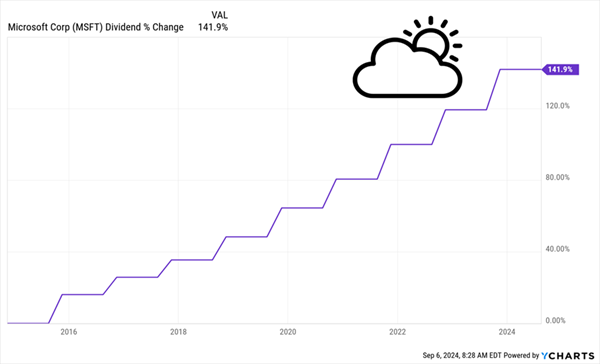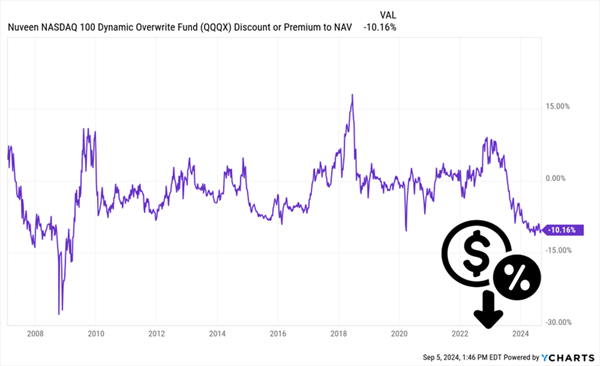I recently had dinner with a friend who’s a small business owner, and he swears by ChatGPT. The tool is saving him time, effort and (to be blunt) future employee hiring.
A lot of people think AI is imploding—hence the selloff in tech stocks we saw following last week’s softer-than-expected jobs report.
But the truth is, AI is simply moving past the initial excitement we see with every new technology. As AI embeds itself in the apps and devices we use every day, it’ll boost productivity, just like it’s doing for my friend.
As that happens, we’ll want to make sure you have some AI exposure in our portfolios, especially as ChatGPT replaces more expensive humans, a trend that’s already in motion, as we can see from last week’s jobs report.
The key for us dividend investors is to buy the bargain-priced AI plays best placed to bank this secure, growing revenue stream. (And of course, we demand big payouts, too!)
Which is where my friend comes in. People like him (he has sole control of his company’s operating budget) are using ChatGPT more and more.
It’s why, according to Bloomberg, ChatGPT creator OpenAI just reached a million paid users for its business versions of the chatbot.
As the number of ChatGPT users grows, they’ll drive up traffic to the Bing search engine from Microsoft (MSFT). That usage will start flowing to Microsoft’s bottom line in a meaningful way soon, since Bing now handles web browsing “referrals” from ChatGPT. That means my friend and other executives like him will be passed from ChatGPT to Bing as appropriate. Cha-ching for Bing!
Sure, Bing is still far behind Google, but Alphabet (GOOGL) has been put on notice.
Microsoft, of course, has a history of smart moves like this. Its Azure service is the main competitor to Amazon Web Services in cloud computing and data storage. Azure profits have powered MSFT’s dividend—up 142% in the past decade.
Microsoft’s Dividend Heads for the Clouds

That was enough to send the yield on a buy made back then to a gaudy 6.4% today. Not bad! A lot better than the roughly 2.2% current yield you’d have gotten 10 years back.
That’s why we love MSFT—dividend growth is where the party’s at here. And I expect its payout to accelerate again thanks to “passed-on” traffic from ChatGPT to Bing. That makes MSFT a savvy buy in September, traditionally a weak month for the stock market, with shares now 12% off their July highs.
A “Backdoor” Way to Grab Double Discount (and a 7% Yield) From MSFT
That all said, here’s something a lot of people don’t realize: You don’t have to wait 10 years to get a big yield from Microsoft. You can grab one (a 7% payout, in fact) right now.
And you can buy the stock at a “double discount,” too!
Our double-discount strategy is an homage to my mother, who never liked paying the sticker price for anything. If there was a coupon somewhere to be found, she’d find it.
But her real claim to shopping fame was not simply her coupon clipping. It was Mom’s ability to find— demand, really—the double discount.
“And then,” her shopping stories would often crescendo, “I got the manager out there, and told him he had to approve this coupon too. So I got another 10% off…”

If you didn’t have a “double discount” shopping win to share, you’d better not bring that weak story to Mom. She’d laugh you straight out of the room!
Luckily for us, demanding a “double discount” from Mr. Market is easier than arguing with a manager at a store: We can do it through a closed-end fund (CEF) like the Nuveen Nasdaq 100 Dynamic Overwrite Fund (QQQX).
As the name says, QQQX holds the stocks in the NASDAQ 100, much like an ETF like the Invesco QQQ Trust (QQQ) does. Since it mimics the index, QQQX gives us a healthy dose of Microsoft, it’s No. 2 holding, at 10.7% of the portfolio. Apple (AAPL), another long-term AI beneficiary as the company’s new AI tools are embedded in its latest iPhones, is the top holding, at 11.7% of assets.
As mentioned, MSFT is down 13% from its July peak, as of this writing. Apple, for its part, is off about 5%. That’s the first part of our double discount here.
It gets better. CEFs, unlike ETFs, generally can’t issue new shares to new investors (hence the “closed” in their name). As a result of that fixed share count, these funds often trade at different values than their underlying portfolios.
And QQQX trades at a discount right now—and no small one, either: at 10.2%, we’re essentially getting our already discounted techs at another 10% off—yep, that’s discount No. 2.
That rings especially true when you realize that QQQX’s five-year average discount is a mere 0.9%, and the markdown is at levels not seen since 2008 (if you set aside the March 2020 “flash crash” in tech).
QQQX’s Once-in-16-Year Sale

There is one other thing that makes QQQX different from its ETF cousin, QQQ. It’s a covered-call fund, meaning it sells covered calls on a portion of its portfolio. That’s how it funds that high dividend.
QQQX’s option strategy also helps iron out volatility, since the fund generates more of its return through the premiums it sells to option buyers for the right to buy its shares in the future. (It keeps this cash no matter how these trades play out.)
You could see that on Friday morning, when QQQX fell far less than QQQ.
The drawback is that covered calls can weigh on returns because the fund’s best performers rise to the option-selling price and get sold, or “called away.”
However, this strategy does work best in volatile markets, and safe to say we’ll see some more rocky days this fall. September is historically the second-most volatile month for the S&P 500. And of course, we still have a contentious (to say the least!) presidential election to get through.
Finally, QQQX’s historic discount also helps hedge its downside (with the fund’s discount essentially at 16-year lows, it’s hard for it to get a lot cheaper), making it a good hold for the volatile months ahead—at least until its discount tracks back to more “normal” territory.
This Monthly Dividend Portfolio Pays More Than QQQX (It’s Cheap, Too!)
The way I see it, there are only things that would make QQQX better:
- A higher dividend yield, and …
- A monthly dividend (QQQX pays quarterly).
Luckily for us, there are plenty more CEFs out there—500 in all—and many of them give us both of those things. I’ve gone through all of them and filtered out the very best ones—at the best values—for my “8%+ Monthly Payer Portfolio.”
As the name says, this unique portfolio kicks out an 8% dividend, and those payouts roll our way every single month. They’re timely buys now, especially as rates fall, making high-income opportunities like this one harder and harder to find.
Don’t miss out on these terrific income plays while you can still get in at a bargain. Click here for all the details and to download a FREE Special Report revealing the names and tickers of all the stocks and funds in my 8%+ Monthly Payer Portfolio.

Recent Comments